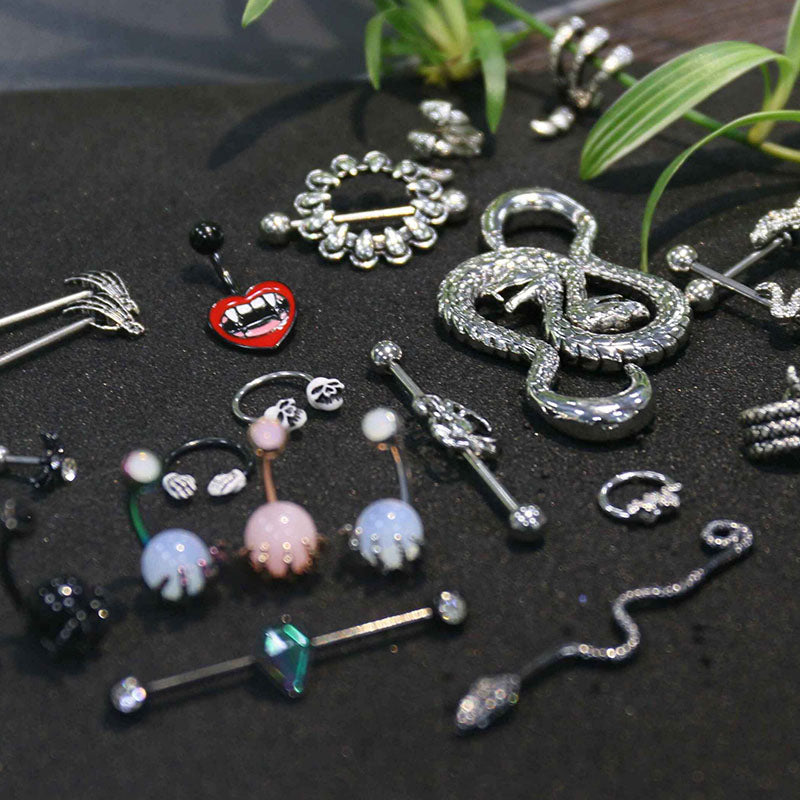
What You Should Do while Your Surface Piercing Heals
Do Keep Your Surface Piercing Clean.
Buy a quality saline rinse, like Recovery Piercing Aftercare Spray and spritz your surface piercing with it 3-6 times a day. You should also do 2-5 minutes long sea salt solution soaks each day during the first couple months of the healing process and any time you experience a surface piercing problem thereafter. You don't need to use an antiseptic rinse unless you develop specific surface piercing problems that can be remedied with an antiseptic. Sea salt solution and saline piercing sprays are the best tools for keeping your new piercing clean.
Do Stay Healthy Overall.
You need a strong, healthy immune system to heal any wound, including surface piercings. To keep yourself healthy during the healing process, it's important to stay hydrated by drinking lots of water, get sufficient sleep every night, eat nutritiously, wash your hands frequently, avoid other people's germs, and minimize stress.
Do Protect Your Surface Piercing.
There are a number of things you can do to protect your surface piercing while it heals. Wear loosely-fitting clothing over your piercing, don't play with your jewelry or touch it at all unless you have to, and definitely don't let other people touch it. When getting dressed, put your clothes on carefully to avoid snagging your surface piercing, too. If you feel it's necessary to cover your surface piercing at night to avoid catching it on your bed linens while you sleep, use gauze or another breathable material.
What You Should NOT Do While Your Surface Piercing Heals
Don't Wash Your Surface Piercing With Soap.
Soap is drying and can delay the surface piercing healing process. It's better to just use saline washes or homemade sea salt solution to clean your piercing. Don't worry if some sudsy water runs over your surface piercing in the shower. You just want to avoid soaping up your piercing directly. If you feel a stronger cleanser is needed at some point, consider using a product intended for piercings once or twice a day, like X-Pressions Extra Strength Antiseptic Piercing Rinse. Just make sure you apply it in between full sea salt solution soaks and aftercare spray spritzes to get the full benefit of each cleanser you use.
Don't Thin Your Blood.
Aspirin, alcohol and excessive amounts of caffeine can thin your blood and make it harder for your body to form clots if you experience any bleeding in the first few weeks after getting pierced. It's best to avoid these things until you've had your surface piercing for a little while. When you need to take an anti-inflammatory for pain and/or swelling, try acetaminophen (e.g. Tylenol) first. Ibuprofen (e.g. Advil) is also a good tool for pain and inflammation that won't thin your blood, but it can compound bruising, so it's better to use acetaminophen during the first few days after getting a surface piercing.
Don't Apply Creams, Oils or Balms to Your Surface Piercing.
These things can clog your fistula (piercing hole), potentially trapping in bacteria and triggering an infection. If the skin around your surface piercing becomes dry or otherwise irritated, you can add tea tree oil to your sea salt solution soaks to take advantage of its moisturizing and antiseptic properties.
Avoid Smoking as Much as Possible.
Smokers have an additional challenge when it comes to surface piercing aftercare, because nicotine has a systemic effect that slows down the immune system and delays healing. If you can't quit smoking entirely, do your best to cut back and substitute cigarettes with low-nicotine alternatives. You can try using a low-dose nicotine patch, nicotine gum, lozenges, or even an e-cigarette filled with low-dose nicotine e-juice.
Don't Change Surface Piercing Tops Prematurely.
With so many cool surface piercing tops available, it can be tempting to change your jewelry early. It's just not a good idea, though, because it takes at least a few months for tissue to grow up and around a surface barbell and secure it in place. Once you reach the 3-month post-piercing mark, visit your piercer and ask him or her if s/he thinks it's safe to change your tops. You might want to just have your piercer change them for you the first time. Before attempting to change your surface piercing tops yourself, consider investing in tools that will make the process easier, like World's Thinnest Microdermal Surface Anchor Holder Tool or jewelry forceps.



Leave a comment
This site is protected by hCaptcha and the hCaptcha Privacy Policy and Terms of Service apply.